Reach to Lukla by Flight or by land for start the Trek
Lukla is a small town and the starting point for all treks to the Everest region, including the Everest Three High Passes Trek. It serves as the main gateway to the region, featuring a small airstrip used by trekkers flying in from other parts of Nepal. Trekkers typically either fly from Kathmandu or Ramechhap, or trek from Phaplu or Jiri to reach Lukla.
Regular flights to Lukla are operated by Tara Air, Summit Air, and Sita Air, departing from either Kathmandu or Ramechhap during the main trekking seasons. The flight from Kathmandu to Lukla takes approximately 25 to 30 minutes.
During peak trekking months—March, April, May, September, October, and November—flights are often rerouted to depart from Ramechhap/Manthali Airport instead of Kathmandu. This adjustment is due to aviation regulations aimed at reducing congestion and delays at Tribhuvan International Airport. Ramechhap is about 144 kilometers east of Kathmandu and requires a 3 to 5-hour drive by private vehicle. The flight from Ramechhap to Lukla takes about 15 to 20 minutes.
Currently, there is a road leading to Surke, which is located about one hour below Lukla. If trekkers have enough time, they can choose to travel by jeep from Kathmandu, avoiding potential flight delays or cancellations. However, this journey usually takes two days.
Best Time to Everest 3 High Passes Trek
The best time for the Everest Three High Passes Trek is during the pre-monsoon (spring) and post-monsoon (autumn) seasons in Nepal. These periods offer the most favorable weather conditions for trekking in the Nepal Himalayas.
Both seasons provide excellent weather, but April, May, October, and November are considered the ideal months for the Everest Three High Passes Trek. These months offer clear skies, moderate temperatures, and better trail conditions. However, weather in the mountains can be unpredictable, so it’s always wise to be prepared for sudden changes. It's recommended to check the weather forecast daily during your trek with your guide.
As you ascend to higher altitudes, temperatures drop significantly. Even in peak trekking seasons, it’s essential to be well-prepared for cold weather and rapid weather changes. Flexibility in your itinerary is important to adapt to any unexpected conditions.
Choosing the best time depends on your preferences, availability, and comfort with crowds, as both spring and autumn have unique advantages.
Winter and summer are not recommended for the Everest Three High Passes Trek. In winter, heavy snow can block the passes—especially Renjo La, Cho La, and Kongma La. In summer (monsoon season), heavy rainfall can lead to landslides, blocked trails, and frequent flight cancellations to Lukla, making it difficult to reach the trekking starting point on time.
Everest Three High Passes Trek Difficulty
The difficulty level of the Everest Three High Passes Trek is considered challenging but highly rewarding. This is due to several factors, including the duration of the trek, its remote location, and the diverse terrain—which includes steep ascents and descents, rocky trails, and potential snow-covered sections, particularly around the three high passes: Kongma La (5,535 m), Cho La (5,420 m), and Renjo La (5,360 m).
Additionally, weather conditions in the high passes are often unpredictable, with cold temperatures and a high chance of snowfall, especially at higher elevations. These elements combine to make the trek both physically demanding and mentally challenging.
Trekking the Three Passes requires a good level of fitness, proper acclimatization, and prior high-altitude trekking experience is highly recommended. However, for well-prepared trekkers, this route offers spectacular Himalayan views, adventurous high-mountain passes, and a deep cultural experience in the Everest region.
Having an experienced guide and porter, proper rain and cold weather gear, staying in teahouses, taking rest days for acclimatization, walking at a steady pace, and taking short, easy steps will help reduce the difficulty and make the Everest Three High Passes Trek more enjoyable and hassle-free.
Acclimatization day to reduce the Altitude Sickness for the Trip
Acclimatization is essential to reduce the risk of high-altitude sickness during the 14-day Everest Three High Passes Trek. This trek takes you through remote, high-altitude terrain in the Everest Region, beginning at 2,800 meters and reaching up to 5,545 meters at Kala Patthar, after crossing three high passes. As altitude increases, oxygen levels and air pressure drop significantly, especially above 3,500 meters, which can lead to altitude-related illnesses.
Symptoms of acute mountain sickness (AMS) may include nausea, vomiting, headaches, loss of appetite, dizziness, fatigue, and difficulty sleeping. To help your body adjust, our itinerary includes a crucial acclimatization day in Namche Bazaar, which allows you to adapt to the elevation gradually and helps prevent altitude sickness.
To minimize the risk of AMS:
- Follow your guide’s instructions carefully, as they are trained in altitude management.
- Stick closely to the acclimatization schedule in the itinerary.
- Drink plenty of water to stay hydrated.
- Eat a nutritious, carbohydrate-rich diet.
- Walk at a steady, comfortable pace.
- Avoid alcohol and sleeping pills.
This careful approach, known as acclimatization, is key to a safe and successful high-altitude trek. However, if symptoms persist or worsen, it is critical to descend to a lower altitude immediately.
Accommodations along the Everest 3 Passes Trek
During the Everest Three Passes Trek, you'll stay in teahouses—basic lodges that provide accommodation and meals. Due to the trek’s popularity, the region has a well-developed infrastructure with numerous lodges and restaurants along the trail. As a result, finding suitable accommodation is generally easy, with little to no difficulty.
Teahouses along the Everest Three Passes Trek are usually simple and offer basic facilities. Rooms are typically twin-sharing or dormitory-style with shared bathrooms. While a few places along the route do offer more luxurious lodging, these are limited and their availability may vary. The quality of the lodges varies from place to place, so you can choose accommodations that best match your budget and preferences throughout the trek.
Hot showers are available at most teahouses along the Everest Three High Passes Trek for an additional charge. These showers are typically heated using gas geysers. However, the cost can be relatively high—ranging from NPR 400 to 600 per shower—especially at higher altitudes where heating water becomes more difficult due to the cold temperatures.
Toilet facilities in the teahouses vary from Western-style toilets to squat toilets and are generally shared among trekkers. As you gain altitude, these facilities may become more basic, again due to the colder climate and logistical challenges.
Food and Drinks along the Everest 3 Passes Trek
Teahouses along the Everest Three Passes Trek offer a variety of meals, including traditional Nepali dishes like dal bhat, as well as international options such as pasta and noodles. Each lodge provides a food menu with similar items, and you are free to choose what you prefer. The food is simple yet hearty, designed to supply the energy needed for trekking. While the cooks are skilled, the taste may differ from that of Western cuisine.
As you ascend, the variety of food options may decrease, and prices may rise due to transportation challenges and high altitude. Meat options are limited and may not always be fresh in the mountains, so it is advisable to stick to vegetarian meals throughout the trek.
Teahouses also offer various hot drinks, such as tea, coffee, and others. Staying hydrated at higher elevations is essential, so you’ll need to drink plenty of water. Although bottled and boiled water are available along the trail, they can be expensive. Many trekkers use water purification tablets or a water filter to treat water from taps or streams. Therefore, bringing a reusable water bottle is highly recommended for the Everest Three Passes Trek.
Requires Permits & Permits Cost for the Trek
The Everest Three High Passes trekking route is located within Sagarmatha National Park in the Khumbu Pasang Lhamu Rural Municipality of the Everest region, Nepal. Therefore, you must obtain both a Sagarmatha National Park entrance permit and a Khumbu Pasang Lhamu Rural Municipality permit. These permits are mandatory for the Everest Three High Passes Trek.
You can acquire these permits through a reputable trekking agency or directly from the Tourism Board office in Bhrikuti Mandap, Kathmandu. Alternatively, the Sagarmatha National Park permit can be purchased in Monjo, and the Khumbu Pasang Lhamu Rural Municipality permit can be obtained in Lukla after starting your trek. You will be required to show and register these permits at every checkpoint along the trail.
If you attempt to trek without the necessary permits, you will either need to buy them on-site at double the cost as a penalty or may be forced to turn back.
The required permits are listed below:
Khumbu Pasang Lhamu Rural Municipality entrance permits
- Cost: US$ 30 per person, per trek for all foreigners
- Cost: US$ 20 per person for SAARC (South Asian Association for Regional Cooperation) citizens
Sagarmatha National Park Entrance Fees:
- Cost: US$ 30 per person, per trek for all foreigners
- Cost: US$ 15 per person for SAARC (South Asian Association for Regional Cooperation) citizens
Luggage Load Carried by Porters during the Trek
If you are doing Three High Passes Trek with just a guide, it will be a cheaper journey, but the guide will not carry your luggage because they are professionals and have their own luggage to carry. In this case, you can hire a porter-cum-guide who handles both guiding and carrying your luggage, typically about 10 to 12 kg.
If you are in a group, we usually assign one porter for every two trekkers, so each trekker's luggage should weigh around 10 to 15kg. If you hire a Porter, a porter typically carries 20 to 30 kg during the trek in Nepal. Trekking with both a guide and a porter highly recommended because they makes walking easier and gives you more free time to enjoy the trekking and climbing, resulting in a memorable trekking experience in Nepal during the Everest Three High Passes Trek.
Electricity and Charging Facilities
Most teahouses along the Everest Three High Passes trail have electricity. Some places are powered by mini hydroelectric plants, especially in villages like Lukla, Phakding, Namche, Thame, and Tengboche, while solar panels are more common at higher-altitude teahouses and other locations.
Charging electronic devices such as phones and cameras usually comes with an extra fee. During the busy trekking season, charging facilities can be in high demand, so it is highly recommended to bring a power bank or a small solar panel to easily charge your devices on the go.
Communication (Mobile & Wi-Fi Network) along the trek
Communication (mobile and Wi-Fi) along the Everest Three High Passes Trek can be challenging due to its remote and high-altitude location. At lower elevations and up to Namche, there is generally good network coverage, but beyond that, mobile signals from providers like Ncell and Nepal Telecom can be irregular and weak, especially in more remote and higher-altitude areas.
If you plan to use your mobile phone, it is advisable to purchase a local SIM card from Ncell or Nepal Telecom in Kathmandu. This may improve coverage in some areas along the trek, but mobile data is not always reliable.
Most teahouses along the trek offer Wi-Fi for an additional cost, usually via a prepaid card system, especially beyond Namche. However, the connection can be slow and intermittent, affected by weather or technical issues. Therefore, we strongly recommend not relying on regular Wi-Fi to stay connected with family and friends. In case of an emergency, your guide will assist you in contacting your family.
Tipping information
The trekking guide and porter are essential to the success of your trip, ensuring it runs smoothly and without issues. Therefore, tipping is an important part of trekking in Nepal, as it shows appreciation for the hard work of the local staff who assist you throughout your journey.
It is customary to tip at the end of the trek. You should gather all team members—guide, porter, and assistant guide—together to distribute the tips. Tips are generally given in cash, preferably in US dollars or Nepalese rupees, and it’s best to use small denominations to make distribution easier.
As a general guideline, tipping around 10% to 15% of the total package cost is customary if you purchase a full package. If not, a tip of $10 to $15 per day per person is recommended. You can adjust this amount based on the quality of service provided.
These tips are highly encouraged to motivate the team and reward them for their outstanding service, contributing to a memorable and inspiring trekking experience.
Equipment & gear list for 3 High Passes Trek
Before departing from your home, it is necessary to pack your trip necessities. While it might be weighty to transport everything from your country to Nepal, some necessary equipment can be rented or purchased in Kathmandu's Thamel area.
For Everest Three High Passes trekking in Nepal, basic but warm gear suitable for all seasons is necessary, although specific items may vary depending on the season and the length of the trekking days you choose.
It is highly recommended to choose lightweight and multi-functional gear and to minimize unnecessary items. This approach will help reduce the weight of your pack and make your trekking experience more comfortable.
Documents:
- Passport and 4 passport size photos
- Travel insurance details (in case an emergency evacuation if needed)
- Boarding passes for flights
- Driver’s license (if needed)
- Cash USD (minimum $500)
- Credit/Debit Card (Ensure you have $500 on your card incase an emergency helicopter evacuation is needed)
Sleeping:
- Sleeping bag (Comfort rating -20 Celsius recommended)
- Sleeping bag liner (Optional) - not necessary
Footwear:
- Trekking boots: one pair lightweight
- Sandals for city and tea house footwear
- Shoes for the plane and tea houses (Optional) - not necessary
- Gaiters for hiking in winter to the base camp
- Thin, lightweight inner socks
- Thick, warm wool hiking socks
Clothing for Body:
Please make sure that you have non-cotton clothing for trekking:
- Base-layer t-shirts (e.g. running t-shirts)
- Fleece/Windproof jacket
- Waterproof jacket
- Down jacket for warmth
- Base-layer trousers (optional)
- Waterproof trousers
- Trekking trousers
- Trekking shorts (Optional)
- Gloves, wool hat and sun hat
- Bandanna or scarf
Health Requirements (Basic First Aid Kit)
- First-aid kit; should contain lip salve, Aspirin, Band Aids, anti-histamine, Imodium or similar tablets for mild cases of diarrhea
- Re-hydration powder, extra prescription drugs you may be taking if any particular
- Wet wipes for cleaning can be purchased in Kathmandu
- Sanitizer, shampoo, Towel, wet wipes and washing soap
Others:
- Sunglasses and Sun cream
- Book (reading and writing materials) - not necessary
- MP-3 /Music, headphones and ear plug (who know some people on group are snoring) as optional.
- A day bag: 35 liters
- A duffel or rucksack with straps to go over your back (Max 12 kg of weight for porters to carry) - normally provide by trekking agency
- Dry Liner or Dry Bag- optional
- Water bottle/thermos/ camel bag: At least 2 L. Nalgen bottles best.
- Mobile and camera charger
- Power Bank
General Toiletries:
- Toilet papers/ tissue – you can buy in Nepal
- Contact lenses, Glasses (if needed)
- 1 medium sized quick drying towel
- Tooth brush/paste (preferably biodegradable)
- Nail clippers
- Face and body moisturizer
- Feminine hygiene products
- Small mirror - optional
- On Personal Hygiene
- Anti-bacterial hands wash
Others (optional):
- Trekking Poles
- Large plastic bags – for keeping items dry inside your kit / duffel bag
- Travel game i.e. chess, backgammon, and scrabble. (For luxuries)
- Binoculars (for luxuries)
- Trail Map/Guide book (if you are alone)




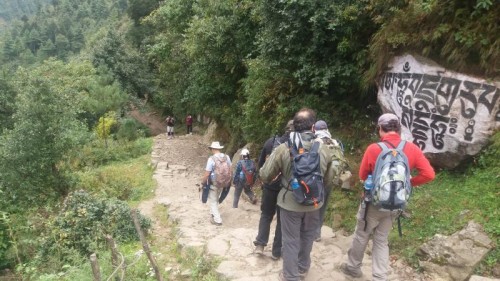

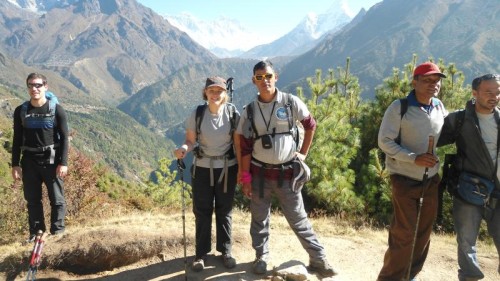

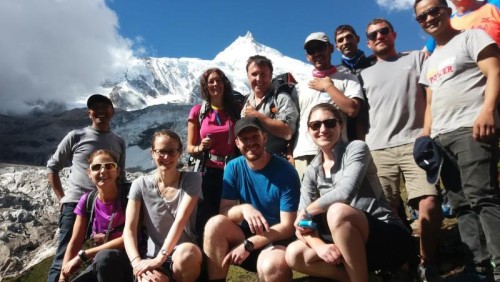
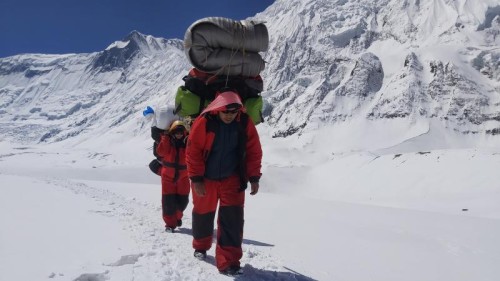


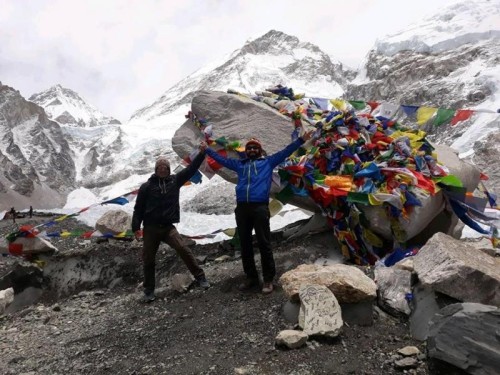
 USD 30
USD 30




Luciana
Brazil
Twice in the Himalayan Mountains with High Pass Adventure
31st May, 2025
We have twice contracted the services of High Pass Adventure. There was amazing trekking moments in 2023 for Everest Base Camp via Gokyo (with guide Ganesh and porter Shiva) and in 2024 for Everest Three High Passes (with guide Gyan and porter Shiva, our mountain hero).
The teams at the High Pass Adventure, in Kathmandu with Ganesh and Purna and during the trekking were very attentive, careful and respectful with us from beginning to end, presenting us with familiar environments with good accommodation and meal options, as well as program optimizations in case of need. Excellent service that I highly recommend! We would hire again at another opportunity.